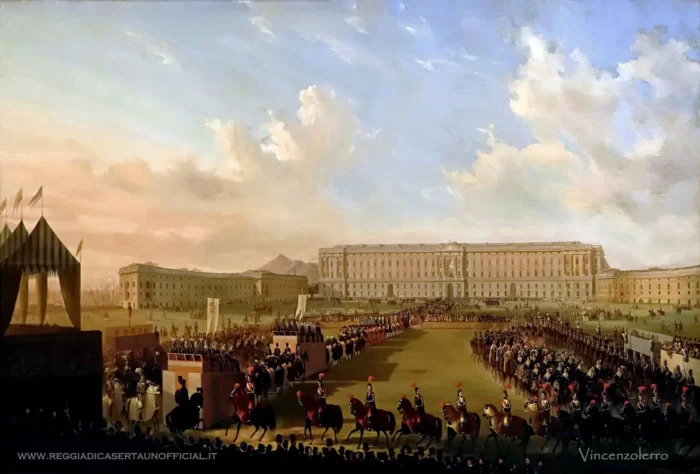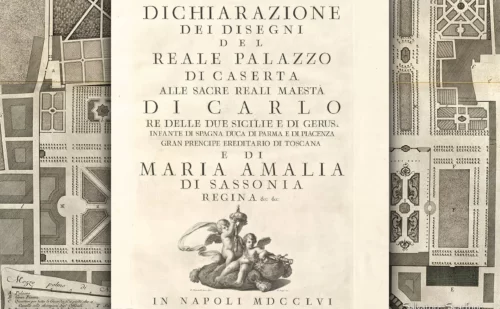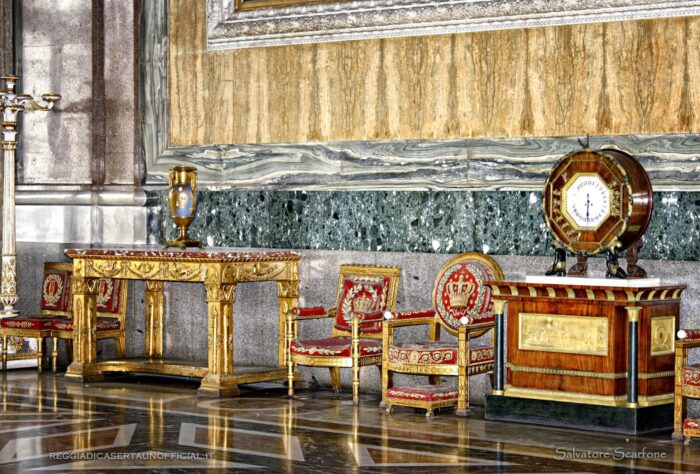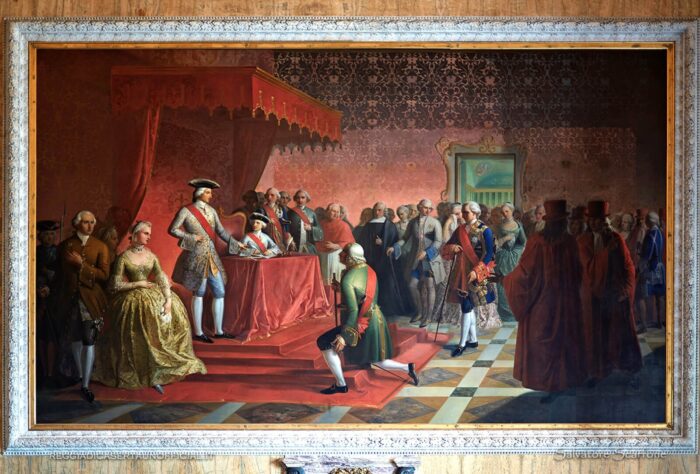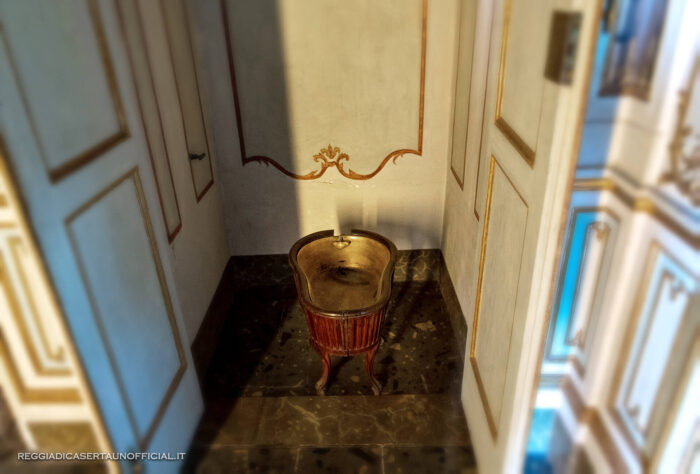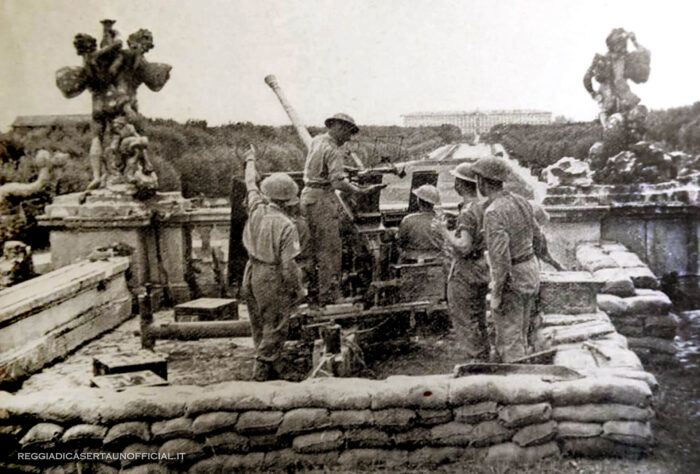History of the Royal Palace of Caserta
History of the Royal Palace of Caserta, the largest Royal Palace in the world that changed the architecture
History of the Royal Palace of Caserta from its creation until the spoliation after the unification of Italy, during the Second World War and until today
Description of the Royal Palace of Caserta by UNESCO:
19 July 1996, Unesco’s nomination for the World’s Heritage List unesco.org
history of the Royal Palace
The history of the Royal Palace started when Luigi Vanvitelli designed it in 1752, the magnificent Royal Palace of Caserta was created to be the core of a new capital city of the kingdom.Even before ascending the throne in 1734, Charles wanted to realize an administrative centre as an alternative to Naples, because the city is located close the the sea, and this represent a risk of invasion, while the feud of Caserta was the perfect solution to these problems. So King Charles bought it in 1750 from the Prince Michelangelo Caetani di Sermoneta, for the amount of 489.393 ducats. The design of the Royal Palace was committed to Luigi Vanvitelli, at the time the first architect of the Factory of San Pietro in Vaticano. The works were solemnly inaugurated on the 20th of January 1752, the same day of the king’s birthday.The original design of the palace already included the Park, but its realization started only one year later, in 1753, and took more than fifty years to be completed.During the first phase, between 1753 and 1773, the Caroline Aqueduct was realized,because it was necessary for the water supply of the Palace and the new capital city.The aqueduct,an amazing piece of engineering that goes through an itinerary of 38 Km,was completed around the 1770.
After 1773, when Vanvitelli died, the works stopped for 4 years. In 1777 his son Carlo, now director of the works, showed to the new king Ferdinand IV a new project, a simplified version of his father’s design. Indeed, economic difficulties and the needs to complete the works quickly forced the reduction of the number of fountains in the second part of the Park. However Luigi Vanvitelli’s design was kept unchanged in the general shape,especially the most prominent thing of its project: the spectacular 3.3km canal of fountains and basins ending with the amazing waterfall.
The building site of the Reggia was initially slowed down by the abdication of the king and Charles of Bourbon for his transfer to the Spanish throne in 1759 and, subsequently, by the fact that his son Ferdinando wanted to finish the palace as soon as possible with the least possible expense.
The death of Luigi Vanvitelli in 1773, the economic crisis and various political events prevented the completion of the project
In 1780 the west side apartments once destined to the princes had been completed, and King Ferdinand I wanted to live there.
THE RULE BY NAPOLEON BONAPARTE AND JOACHIM MURAT
The Giuseppe Bonaparte era
During the Bonaparte domination there are no works carried out in the Royal Palace, but the splendid chairs and armchairs of the Alexander Room were brought by him from the Tuileries Palace.
The chairs from the Tuileries Palace, now in the Antechamber of the Untitled
The Joachim Murat era
With Gioacchino Murat, proclaimed king of Naples in July 1808, it seemed that the capital was revived under a rush of youth, in a heat of renewed hopes. And the history of the Royal Palace of Caserta was also affected. In December of the same year, the court architect, Antonio De Simone, gave the palace aides orders for the resumption of the work that had to be carried out no longer following the old directives, but according to the new style that triumphed in France.
Carlo Vanvitelli had left the yard; of the well-known artists, Tommaso Solari had died in ’79, his son around ’90; Andrea Violani had moved to Rome in 1803. And Bonito, De Mura, Fischetti, Mondo and Rossi were also dead. We no longer know anything about the others except for Lucio Lucchesi and Carlo Beccalli, who were resumed into service as carver echelons.
Under the Murat domination, works were carried out in the Alexander Room, where the painters Heinrich Schmidt and Rudolf Suhrlandt were commissioned to fresco the capture of Capri and the battle of Eylau on the main walls, and to the sculptors Domenico Masucci, Claudio Monti and Durand (quest last, French, not better indicated in the documents) to model six stucco bas-reliefs to be placed on the doors to represent episodes from the life of Joachim Murat. The splendid Halls of Astrea and Mars, both splendid projects by the architect Antonio de Simone, were also carried out under the Murat dominion. So also the Murats made the history of the Royal Palace of Caserta
The return of the Bourbon
At the return of the Bourbons on the throne he did not dare to destroy the beautiful furnishings brought by Bonaparte and Murat as well, for example, the chairs of the Alexander Hall the initials of Joseph Bonaparte were replaced with those of Ferdinand, while always in the Alexander Hall the two large paintings and the bas-reliefs above the doors were replaced, as they praised Murat.
In 1830 the king died, and no work was done until 1839 when the Throne Room project was resumed, and completed in 1845.
THE END OF THE KINGDOM, THE UNITY OF ITALY AND THE SPOLILATION
It is said that in this Palace a monk predicted the end of his reign to King Ferdinand II:
Pay attention, Majesty – said that friar – that time is pressing; events precipitate; the earth is already beginning to shake under your feet … Majesty, if you do not sweep the palace from the rubbish that profane it … These great ones, who surround you, are all blind and traitors …
In 1859 King Ferdinand II most likely died following a long agony in due to a poisoning, when he should have been at the wedding of his heir. And he was succeeded by the 23yo king Francesco II, the last king of the Two Sicilies, who reigned for less than two years before the Kingdom was attacked before the Kingdom was attacked by the Savoy supported by the English Freemasonry. In those years the Suez Canal was under construction, and since the Bourbon fleet dominated the Mediterranean, the Kingdom was attacked to prevent it from becoming the main exploiter of the economic advantages of the Suez Canal to the detriment of the British.
After the conquest of the Kingdom, Giuseppe Garibaldi changed the history of the Royal Palace of Caserta by settling in it making it his headquarters, and starting his spoliation.
In 1919 the Savoys ceded the Bourbon palaces of Naples, Caserta and Capodimonte to the Italian State, which had them managed by the Ministry of Education (the Royal Palace of Caserta risked becoming an office, a barracks or a hospice).The Royal Palace of Carditello was partly sold and transformed into offices, and those ones of Portici and San Leucio had no better fate.
history of the Royal Palace DURING THE SECOND WORLD WAR
The German and Anglo-American occupation
The history of the Royal Palace of Caserta also continued during the Second World War when the city of Caserta hosted a deployment of Nazi troops.
Hitler, as is known, raided works of art throughout Europe, and since the Palace became the headquarters of the German troops, it is logical to assume that many works of art ended up abroad.
Later the city of Caserta was bombed, and the Reggia was damaged. It then became the Allied Headquarters in the Mediterranean for British and American troops. Thus, the Royal Palace of Caserta became a large military citadel, or what was called the Allied Force Headquarters.
Tempted as it is to protect the works of art, it was impossible to avoid theft and damage. It is no coincidence that, periodically, objects from the Royal Palace of Caserta or with the imprinted coat of arms of the Bourbons appear in the major international auctions. Even international museums possess objects and documents such as, for example, part of the original plans for the Palazzo.
The surrender at Caserta and the end of World War II
The Surrender of Caserta was the final formal act that sanctioned the end of the Italian campaign and the definitive defeat of the Nazi-Fascist armed forces in Italy during the Second World War.
The act, entitled Instrument of local surrender of German forces and other forces placed under the command or control of the German South-West Command and its annexes, was signed in Caserta on April 29, 1945 in the presence of British and American delegated officers. Germans and a Russian observer: it provided for an unconditional surrender that was to become operational from 2 May.
In the document drawn up, the German armed forces were associated with those of the Italian Social Republic since it, being considered a puppet state and therefore not recognized by the allied forces, was unable to enter into direct agreements with the latter: for this reason the German representative it was equipped with a written proxy issued by the Minister of Defense of CSR Rodolfo Graziani.
THE AIR FORCE
After the disastrous war events of the Second World War, where among other things, many specialists trained in Capua and Capodichino, wrote epic pages of the Regia Aeronautica in the entire international chessboard, the School, on 1 October 1948, was reconstituted at the Royal Palace of Caserta with the denomination of School of Specialists of the Military Air Force.
The Vanvitellian complex, which was best suited to the training needs of specialists, was already the seat of military institutions such as the Army Non-Commissioned Officers School from 1888 to 1895, the Academy of the Guardia di Finanza from 1896 to 1925 and above all of the Air Force Academy from 1926 to 1943.
From that moment on, the activities of the Specialists School resumed with the same methodologies also in the context of the newly established Military Air Force which made room for the Regia Aeronautica. The 1st Specialist Course was incorporated in Caserta in 1949.
The School therefore dealt, from the beginning, with the theoretical instruction of the specialist students, while the professional practice lessons were always held at the Capua air base, where G-12 aircraft specially equipped as “flying classrooms” were used, in order to put into practice the activities and specialized disciplines learned during the theory.
Since 2016, the progressive transfer of the Air Force to other structures has begun, in order to completely free the museum spaces.
External links
